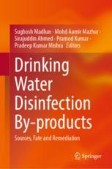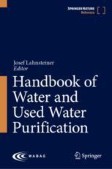Search
Search Results
-
Identification of disinfection by-product precursors by natural organic matter fractionation: a review
During disinfection of drinking water, natural organic matter reacts with chlorine to produce harmful disinfection by-products. The identification of...

-
Various Disinfection Processes and Formation of Disinfection by-Products in Drinking Water
The increase in the urban population means that water consumption is increasing. In this way, several methods to produce drinking water have been...
-
Improved fractionation method using amphipathic NDAM for the efficient separation of disinfection by-product precursors in natural organic matter
The hydrophilic substances in natural organic matter (NOM) are the main precursor of disinfection by-products (DBPs) formed during disinfection...

-
Alternate disinfection approaches or raise disinfectant dosages for sewage treatment plants to address the COVID-19 pandemic? From disinfection efficiency, DBP formation, and toxicity perspectives
During the COVID-19 pandemic, most sewage treatment plants increased disinfectant dosages to inactivate pathogenic viruses and microorganisms more...

-
Water Disinfection: Background, Current Trends, Challenges, and Gaps
World’s population is growing rapidly and it will touch 10 million by the end of 2050. Availability of clean and safe water for all is a global...
-
Disinfection in Water and Used Water Purification
Disinfection in water treatment has a long tradition. In the course of time, five processes/agents have established themselves in water technology....
-
A Comparative Study of Different Disinfection Processes, and Management Practices to Control the Formation of Disinfection by-Products (DBPs)
The disinfectant chemical that is most frequently utilized is chlorine. The most popular kinds are calcium or sodium hypochlorite and chlorine gas....
-
New diamond coatings for a safer electrolytic disinfection
In this work, a new coating of boron-doped diamond ultra-nanocrystalline (U-NBDD), tailored to prevent massive formation of perchlorates during...

-
Physicochemical methods for disinfection of contaminated surfaces – a way to control infectious diseases
This paper represents the reviews of recent advancements in different physicochemical methods for disinfecting contaminated surfaces, which are...
-
A new process to further remove dissolved organic matter and disinfection by-product formation potential during drinking water treatment
Biological activated carbon (BAC) will produce soluble microbial products (SMPs), which affect effluent quality. To clarify the mechanism by which...

-
Impact factors and pathways of halonitromethanes formation from aspartic acid during LED-UV265/chlorine disinfection
Light emitting diode (LED-UV)/chlorine disinfection can replace UV/chlorine disinfection in wastewater treatment plants and water supply plants....

-
Classic and alternative disinfection practices for preventing of hospital-acquired infections: a systemic review
Ultraviolet (UV) disinfection technologies are well-known tools for microbial prevention in indoor public places which are frequently employed for...

-
Bibliometric analysis of electrochemical disinfection: current status and development trend from 2002 to 2022
The removal of waterborne pathogens from water is critical in preventing the spread of waterborne diseases. Electrochemical methods have been...

-
Membrane and Disinfection Technologies for Industrial Wastewater Treatment
Industrial wastewater is a multifaceted mixture of both organic and inorganic compounds such as, heavy metals, ionic components, salts and nutrients....
-
Detection and Measurement of Disinfection By-Products in Drinking Water
It is very important to identify and precisely quantify disinfection by-products (DBPs) in water to make sure it is safe for drinking and of good...
-
Resolving the “health vs environment” dilemma with sustainable disinfection during the COVID-19 pandemic
The overuse of disinfection during the COVID-19 pandemic leads to an emerging “health versus environment” dilemma that humans have to face....

-
Bromide induced the formation of brominated halonitromethanes from aspartic acid in the UV/chlorine disinfection process
Brominated halonitromethanes (Br-HNMs) are generated in water disinfection processes and present high toxicity to human health. This work used...

-
Technology assessment of solar disinfection for drinking water treatment
Poor access to safe drinking water is a major sustainability issue for a third of the world’s population, especially for those living in rural areas....

-
Wastewater substrate disinfection for cyanobacteria cultivation as tertiary treatment
Cultivation of microalgae or/and cyanobacteria in nutrient-rich wastewaters offers an opportunity for enhancing sustainability of tertiary wastewater...

-
Cocamidopropyl betaine — a potential source of nitrogen-containing disinfection by-products in pool water
Water treatment for most public pools involves disinfection with active chlorine leading to the formation of disinfection by-products (DBPs). Among...

